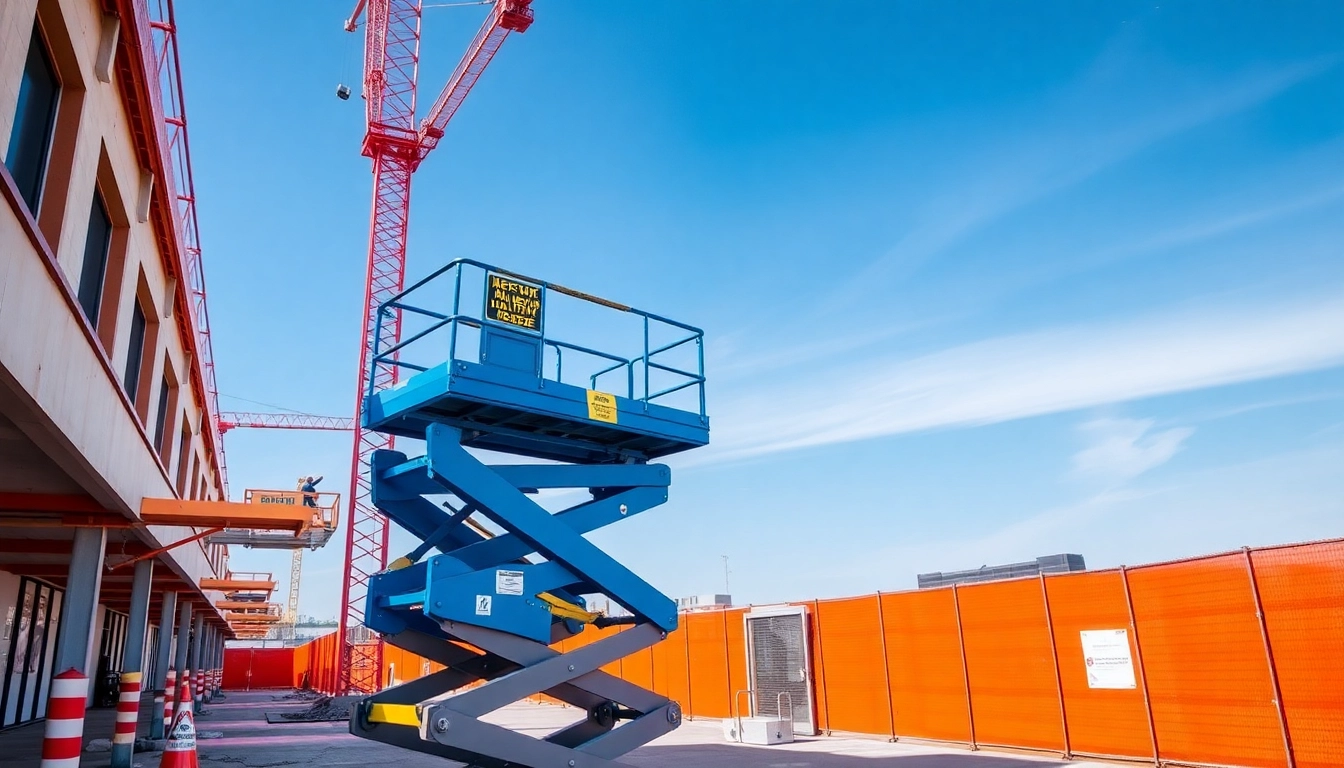Comprehensive Guide to Aerial Work Platforms Rental: Choosing the Right Equipment for Your Projects
In the dynamic world of construction, maintenance, and industrial operations, ensuring worker safety and operational efficiency at height is paramount. Aerial work platforms (AWPs), also known as mobile elevating work platforms (MEWPs), have become indispensable tools for accessing elevated work areas safely and effectively. Whether your project involves indoor repairs, outdoor infrastructure, or complex construction tasks, choosing the right aerial work platforms rental can significantly impact productivity and safety outcomes. Aerial work platforms rental services offer a broad array of equipment to cater to diverse needs, from compact scissors for indoor tasks to extended boom lifts for outdoor applications. This comprehensive guide delves into the nuances of selecting, using, and maximizing aerial work platforms, providing industry insights, practical tips, and expert recommendations to optimize your investment and ensure project success.
Understanding Different Types of Aerial Work Platforms
Scissor Lifts vs. Boom Lifts: Features and Benefits
When considering aerial work platforms, one of the primary distinctions is between scissor lifts and boom lifts. Both serve the purpose of elevating workers and equipment but are optimized for different scenarios based on their design, range of motion, and job site requirements.
Scissor Lifts
Scissor lifts are characterized by their rigid, crisscrossing supports that extend vertically, providing a stable working platform. They excel in tasks requiring a straightforward vertical lift, such as interior maintenance, warehouse stocking, or installation work where lateral reach is minimal. Their features include:
- High load capacities suitable for multiple workers and equipment
- Ease of operation with simple controls
- Compact footprint, allowing access in tight spaces
- Electric or diesel-powered options for indoor and outdoor tasks
For instance, a Genie AWP30S offers a working height of approximately 10.8 meters and is ideal for indoor maintenance projects.
Boom Lifts
Boom lifts, also known as cherry pickers or articulating/ telescopic booms, feature a platform mounted on a hydraulic arm capable of extending both vertically and horizontally. They are versatile, allowing access to hard-to-reach places around obstacles or over rough terrain. Their advantages include:
- Extended reach capabilities in both height and lateral distance
- Articulating arms for complex access scenarios
- Suitable for outdoor construction, electrical line work, and infrastructure repairs
For example, a telescopic boom lift can reach 30 to 60 meters, making it suitable for large-scale outdoor projects.
Indoor vs. Outdoor Aerial Platforms: Which One Fits Your Needs?
The decision between indoor and outdoor aerial platforms hinges on environmental conditions, power sources, and specific project requirements. Indoor platforms typically feature electric drives, ensuring zero emissions and quiet operation—ideal for confined spaces, warehouses, or clean environments. Conversely, outdoor platforms are built for rugged terrain, often equipped with all-wheel drive and diesel engines for greater power and mobility.
For indoor tasks like electrical fixture installation or maintenance, electric scissors lifts provide a clean, emission-free solution. In contrast, outdoor tasks such as bridge maintenance or building facade repairs often require robust diesel boom lifts capable of handling uneven terrain.
Key Specifications to Consider: Height, Load Capacity, and Mobility
Selecting the appropriate aerial work platform involves analyzing various technical specifications:
- Working Height: Ensure the platform’s maximum height exceeds your required working elevation, factoring in operator safety margins.
- Load Capacity: Determine the combined weight of personnel, tools, and materials to select a platform with adequate capacity.
- Mobility & Movement: Consider the platform’s maneuverability on your site, including turning radius, drive type, and ease of transport.
Choosing equipment that matches your project scope prevents operational delays and enhances safety.
Factors Influencing Aerial Work Platforms Rental Decisions
Project Scope and Duration: Short-term vs. Long-term Rentals
The scope and duration of your project significantly influence rental strategies. Short-term rentals are suitable for discrete tasks like minor repairs or one-off installations, offering flexibility and cost-effectiveness. Long-term rentals benefit ongoing projects, maintenance contracts, or seasonal preparations, often allowing for better negotiation and equipment customization.
For example, a main contractor might rent a cherry picker for a critical week of façade work, whereas a utilities company may opt for a month-long rental of large boom lifts for infrastructure upgrades.
Safety Standards and Compliance Requirements
Adherence to safety standards is non-negotiable. UK-based projects must comply with regulations such as the Work at Height Regulations 2005, which mandate safe access and working practices. When selecting a rental provider, verify that equipment meets relevant standards, including CE marking, PPE requirements, and operators’ certifications.
Choosing certified, inspected equipment reduces legal liabilities and enhances safety management.
Budget Considerations and Cost-saving Tips
Cost management is crucial. While rental rates vary based on platform type, duration, and additional services, there are strategies to optimize expenditure:
- Book equipment ahead of schedule to secure better rates
- Coordinate multiple requirements with a single provider to leverage volume discounts
- Opt for multi-use platforms that can serve various tasks, reducing the need for multiple rentals
- Ensure proper operator training to minimize downtime caused by misuse or mishandling
Balancing quality and cost entails evaluating the total cost of ownership versus the benefits of reliable, well-maintained equipment.
Best Practices for Safe and Efficient Usage
Inspection and Maintenance Before Use
Pre-operation inspections are critical to identify potential issues, verify equipment functionality, and ensure safety. Key checks include hydraulic systems, tires/wheels, control functions, safety devices, and structural integrity. Regular maintenance, aligned with manufacturer guidelines, prevents unexpected breakdowns and extends equipment lifespan.
Operator Training and Certifications
Qualified operators are central to safe aerial work platform operation. It’s essential that personnel hold recognized certifications, such as IPAF (International Powered Access Federation) courses, and receive site-specific training on equipment controls, safety protocols, and emergency procedures. Additional competencies include understanding load limits and the importance of stability.
Maximizing Productivity with Proper Planning
Effective project planning minimizes idle time and facilitates smooth operation. Key steps include:
- Scheduling equipment delivery during low-traffic periods
- Preparing the work area by removing obstacles and securing the site
- Designating a site supervisor to coordinate with operators and adapt plans as needed
- Ensuring communication devices are available for team coordination
Utilizing a detailed task analysis ensures the right platform is used appropriately, reducing operational delays.
Top Tips for Finding Reliable Aerial Work Platforms Rental Providers
Evaluating Provider Reputation and Customer Reviews
Reputation is paramount when selecting a rental partner. Look for providers with positive customer feedback, transparent service records, and compliance credentials. Digital reviews, industry awards, and recommendations from colleagues can inform your choice. For example, Rentmas has established a strong reputation for reliability and customer service in the UK market.
Assessing Available Equipment and Support Services
Verify that providers offer a wide range of equipment tailored to your needs, including different platform types, sizes, and capabilities. Additionally, assess support services such as:
- 24/7 customer support for emergencies
- On-site technical assistance
- Flexible rental terms and quick delivery options
that facilitate seamless operations.
Considerations for Seamless Rental and Logistics
Efficient logistics reduce downtime. Key considerations include equipment delivery scheduling, site access for vehicles, and removal procedures post-project. A reputable provider will coordinate closely to streamline these processes and provide quick turnaround times.
Maximizing ROI from Your Aerial Work Platforms Rental
Planning Projects to Optimize Platform Utilization
Strategic planning involves aligning equipment selection with project phases. Combining tasks to reuse platforms, scheduling overlapping activities, and avoiding unnecessary redeployments enhance cost efficiency. For example, staging equipment close to the worksite minimizes transit time and accelerates progress.
Integrating Rental Equipment with Other Construction Tools
For complex projects, integrating AWPs with scaffolding, cranes, and power tools creates a cohesive workflow. Proper coordination ensures safety and productivity. Detailed site plans and equipment layouts help prevent conflicts and optimize space usage.
Measuring Success: Safety, Efficiency, and Cost Savings
Define clear KPIs such as safety incident rates, project completion times, and budget adherence. Regular performance reviews and feedback mechanisms help identify improvement areas. Data analysis enables continuous optimization of rental strategies and operational practices, ultimately delivering greater ROI.









